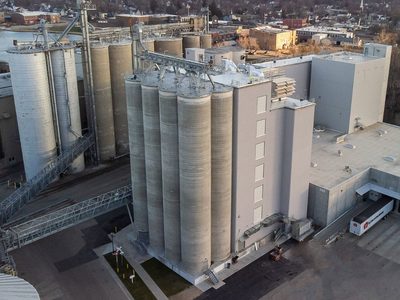Components of the pelleting process, such as steam conditioning and feed retention time in the conditioner and die, expose feed to various degrees of heat, moisture, pressure, and sheer, which changes its physical and chemical characteristics.
When ingredients that make up a diet formulation are exposed to the steam conditioning process and extrusion through the die, the heat and moisture plasticize the soluble fractions of the diet and increase the agglomeration of dietary components (Lundblad et al., 2009). Pelleting swine and poultry diets is commonly used to improve nutrient utilization, feed efficiency, feed handling characteristics and bulk density. Most of the improvement in swine or poultry feed efficiency due to pelleting can be attributed to a decrease in feed wastage. However, it is often discussed how much of the pelleting benefit can be attributed to improvements in nutrient digestibility.
Previous research observed that feeding pelleted diets increased DM, N, and GE digestibility compared to feeding meal diets when fed to pigs (Wondra et al., 1995). More recently, Rojas et al. 2017 observed that pelleting a corn-soybean meal diet increased the digestibility of DM, N, and GE by 5% to 8% compared with feeding the same diet in a mash form.
Although these reports demonstrated improvements in digestibility, there is still discussion about how pelleting affects different nutritional components and which nutrients are leading to the benefits in performance. In addition, recent issues of feed safety and importance of pellet quality have led feed manufacturers to steam condition diets at higher temperatures to decrease pathogen load and improve pellet quality.
This begs the question: Are there potential negative impacts on nutrient digestibility when pelleting diets at high temperatures? Ultimately, the improved performance response to pelleting is multifactorial. However, this article will focus on the impacts it has on specific nutrient digestibility.
Starch
Starch is the major energy source in livestock diets, comprising up to 50% of monogastric diets primarily supplied by grains. Starch digestion largely is driven by amylase, a glycolytic enzyme that degrades starch into sugars that are more readily available for absorption in the small intestine. Pelleting of corn- and soybean meal-based diets increase starch availability through a process known as starch gelatinization.
Gelatinization is a four-step process that irreversibly solubilizes raw starch granules through the addition of heat and moisture. Different cereal grains have different starch gelatinization characteristics (Lund 1984) where gelatinization temperatures of wheat (137°F) and sorghum (163°F) starches are lower and higher, respectively, than that of corn (153°F). When exposed to the conditioning process, starch granules begin to swell and as feed passes through the die the frictional heat and pressure drives starch gelatinization (Truelock et al. 2020). The pelleting process increases starch gelatinization from approximately 6% in mash feed to 10% to 11% in pelleted feed (Lewis et al., 2015).
This demonstrates how the degree of gelatinization is substantially less during the pelleting process as compared to other processes such as extrusion. Although only a small amount of starch is gelatinized in the pelleting process, Rojas et al. (2016) reported an increase in apparent ileal digestibility of starch (98%) compared to mash diets (96%) when fed to pigs. Starch that bypasses ileal digestion is easily fermented in the hindgut, while starch digested in the small intestine as glucose is a more efficiently utilized energy source than microbial fermentation for volatile fatty acid absorption in the hindgut (Rojas 2016).
Multiple studies have determined a different response in poultry as compared to pigs. Pelleting corn-based diets did not lead to improvements in starch digestibility (Abdollahi et al., 2013; Massuquetto et al., 2017).
Non-starch polysaccharides
Classifying additional carbohydrate types include soluble or insoluble non-starch polysaccharides (NSP), traditionally referred to as fiber. In monogastric diets these can make up 10% to 75% of the chemical composition of a feed ingredient (Choct 2015). Additionally, these non-starch fractions of cereal grains become most concentrated in byproducts that can make up greater than 50% of diet composition due to reduced cost.
The addition of complex carbohydrates will solubilize in the intestinal tract leading to decreased rate of feed passage, reduced feed intake, and proliferation of bacteria in the gastrointestinal tract (Abdollahi et al. 2013). Rojas et al. (2016) observed when pelleting low-fiber, medium-fiber, and high-fiber diets, ME increases 2.1%, 2.5%, and 1.9% as a result of pigs fed pelleted diets compared to mash diets.
The authors concluded that the improvement in energy digestibility was not a result of increased fermentation of fiber but likely a result of the increased digestibility of starch and AA. In contrast, Gall et al. (2009) observed an improvement in NDF digestibility but no difference in ADF digestibility when pigs were fed pelleted as opposed to mash diets. However, the authors observed no shift in dietary fiber fraction composition (NDF, ADF, etc.) due to pelleting.
Pelleting also has demonstrated improvements in NSP digestibility in poultry. However, inconsistent results also have been observed. The variability in the response to NSP digestibility can be attributed to the different fractions that compose NSP and the temperature and shear applied during the process. For example, hydrothermal processing is more likely to influence NSP digestibility when ingredients contain solulizable NSP, such as β-glucan, as compared to complex arabinoxylans (de Vries et al., 2012).
Fats and oils
Fats and oils can be naturally occurring in ingredients (intact fat) or can be added to the mixer. Previous research has demonstrated that when a majority of the dietary fat is intact fat contained within ingredients such as corn, pelleting improved the ileal digestibility of fat in broilers (Abdollahi et al., 2013).
Typically, intact fats are encapsulated by cell walls within the grain. Therefore, disruption of these cell walls during the pelleting process provides greater access to digestive enzymes.
Zelenka (2003) demonstrated a similar improvement in fat digestibility when pelleting broiler diets with no added fat. However, the pelleting process does not seem to have the same effect when pelleting diets containing a majority of the fat as added fat (Abdollahi et al., 2013).
Rojas and Stein (2017) developed a similar hypothesis in pigs, that conditioning or pelleting may disrupt some of the matrixes that prevent intact fat from being digested. However, it is evident that more research is needed to determine the effects of pelleting on the ileal digestibility of acid hydrolyzed ether extract to truly understand the response in pigs.
It has been consistently demonstrated that pelleting swine diets is somehow altering the digestibility or metabolism of fat in finishing pigs. Nemechek et al. (2015) observed that pelleting finishing pig diets increased unsaturated fatty acids deposition and carcass fat IV. The authors hypothesized that pelleting increased exogenous fat digestibility, increasing deposition of carcass fat from dietary oil.
Protein
Proteins exposed to pelleting disrupt the tertiary structure, which can lead to irreversible protein denaturation or binding of amino acids. In general, heating improves protein digestibility by inactivating enzyme inhibitors and denaturing protein to increase opportunity for digestive enzyme exposure. However, a combination of high temperature, shear force, and moisture during the pelleting process can potentially lead to the Maillard reaction.
In the Maillard reaction, free amine groups at the N-terminus of an amino acid interact with the free aldehyde group of reducing sugars, such as glucose, galactose, and fructose. This potentially decreases the availability and utilization of those nutrients (Pahm et al., 2008).
The structure of lysine makes it particularly susceptible to the Maillard reaction as it has two free amino groups. Maillard reactions with lysine result in a reduction of both lysine concentration and lysine digestibility (Gonzalez-Vega et al., 2011), whereby binding the utilization of a limiting amino acid.
Increasing temperature has a positive linear effect on the Maillard reaction (Ajandouz et al., 2008), indicating the potential for the pelleting process to contribute to reduced lysine utilization and ultimately decreased performance. Therefore, it is important to understand how the pelleting process can influence the digestibility of AA to accurately meet the AA needs of swine and poultry during diet formulation.
The influence of pelleting on nutrient digestibility of AA in broilers has varied. The variation of this response can be attributed to a multitude of factors. However, pelleting parameters are a key component. Increasing the conditioning temperature (10-second conditioner retention time) from 165ºF to 195ºF and 203ºF has been reported to reduce the digestibility of some AA in a corn SBM-based diet (Loar et al., 2014).
In contrast, Boltz et al. (2020) observed improvements in AA digestibility when increasing conditioning temperature from 171ºF to 190ºF when conditioned for 30 seconds and from 171ºF to 180ºF when conditioning for 60 seconds.
It has been demonstrated that pelleting may influence AA digestibility in poultry, but more research is needed to continue to define the response. An improvement in AA digestibility has been observed feeding pelleted diets compared to mash diets in pigs (Rojas et al. 2016; Dunmire et al., 2020). However, the recent increase in the use of supplemental crystalline amino acids has increased in an effort to reduce feed costs along with inclusion of byproduct ingredients in swine and poultry diets.
Also, feed safety issues and the importance of pellet quality have led producers to steam condition diets at high temperatures during the pelleting process. This combination presents increased risk for the Maillard reaction to occur. Recent research at Kansas State University evaluated diet formulated with low or high crystalline amino acids and low or high reducing sugars provided by co-product ingredients, DDGS, and bakery meal to increase the opportunity of binding lysine via the Maillard reaction (Dunmire et al. 2020). Diets were pelleted to a target conditioning temperature between 175ºF and 185°F. There was no evidence of interactions between diet types, indicating that increasing amounts of crystalline amino acids and reducing sugars did not increase the Maillard reaction or reduce amino acid digestibility when pelleting diets by using the reported conditions. Pelleting diets did result in improved AA digestibility. Therefore, it is speculated that traditional pelleting conditions are too mild to cause the Maillard reactions.
In summary, pelleting influences many chemical and physical characteristics of feed. Remaining vigilant to these changes can create opportunity to provide more precise diet formulation and better utilization of feed ingredients from both a digestibility and economic perspective.
Pelleting to conditions whereby starch gelatinization and protein denaturation occurs is important to observe potential differences in digestibility. However, exceeding thermal processing conditions to the extent of binding or destroying nutrients in the process can partially or fully offset the benefits. Therefore, it is important to consider all factors of the pelleting process and animal performance to capture the most economic value.






